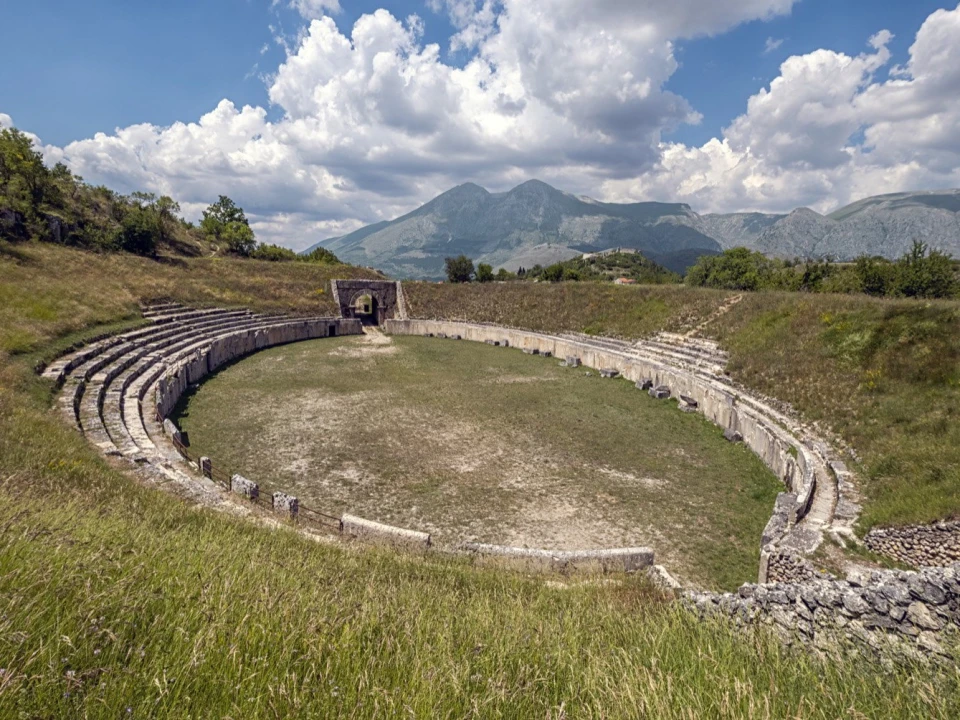Alba Fucens, ancient Roman city at the base of Monte Velino (Province of L’Aquila), is an archaeological jewel that one should most definitely explore. In fact, the ruins that emerged from excavations initiated by Fernand De Visscher in 1949 (continued throughout the 20th Century and recently taken up again) are truly remarkable.
Given that the city lies in a rather strategic position, at the intersection between the territories inhabited by the Marsi and Equi, it was long contested between the two tribes. It became a Roman colony in 303 B.C., and eventually received the status of municipality.
Constantly allied with Rome, it helped to defend the Empire against Hannibal during the Second Punic War, and continued to demonstrate its loyalty during the Social War. However, for having taken the side of Marius against Sulla, its territory was parceled up (centuriation) and given to veterans of Sulla’s lieutenants. Having been part of the war between Pompei and Caesar, the city became a stronghold for the Anti-Caesarians commanded by Domitius Ahenobarbus, who later surrendered to Caesar.
In the Imperial Age Alba Fucens was thriving and prosperous; its archaeological remains testify to such, including a dominating amphitheatre that was commissioned by the Praetorian prefect Naevius Macro. Because after a succession of events, Macro was condemned by Caligula and stripped of his office, he soon committed suicide – but not before he requested the amphitheatre’s construction, in order to leave his legacy on his birthplace.
Among other finds discovered within the last century, one can admire the macellum or marketplace, the thermal spas (rich in mosaics and marine representations), the baths (male and female), and the pagan chapel of Hercules.
Structured as a tipical Roman fortress, the city developed along a grid of the ancient decumanus and cardo roads. Taking the Decumanus Maximus (present-day Via del Miliario), visitors can see an ancient domus romana divided into apartments featuring dry-wall construction, characteristic mosaics and typical pagan votive spaces; and stroll along its columns and peristiles raised up again by archaeologists. Notice the craftsmanship of the milestone (marking the 68 Roman miles to the Imperial Capital) and depicting a gladiatorial battle with an inscription to the usurper-Emperor Flavius Magnentius. On the other side, on the so-called Via dei Pilastri, are located the ancient tabernae with their original pavements, lead water ducts, and the counters and sinks of a wine bar.
The enormous walls defending the city have also been very well preserved; they counted four entrances and extended for 3 km (1.86 mi) around the inhabited zones.
Remnants of the city’s theatre (on the Pettorine Hill, a natural buttress for Alba Fucens), evoke the image of a rich cultural life financed by the wealthy merchants of the day.
The subterranean zone, first explored by the Irish archaeologist Dodwell, reveals an efficient sewage system (the cloaca maxima) in polygonal masonry, a unique example in all of Italy that is the subject of study by both archaeologists and speleologists.
Of particular interest is the Church of San Pietro from the 12th Century, partially destroyed by the earthquake of 1915. Built on the city’s highest hill – above a pagan crypt making up the Temple of Apollo – the Christian church still preserves excellent sculpture work, such as the spiral columns of the iconostasis (the dividing wall usually used in Eastern churches) done in the Cosmatesque style. Greatly appreciated is the church’s apse, which on its exterior is decorated with theriomorphic motifs.
The amphitheatre, with optimum acoustics, is used today for cultural events, concerts and theatrical works of the Greek and Latin classics.
The site is always open, and visitors can see it all for free unless they prefer a guided visit. Headstones, coins, vases, statues and other finds from Alba Fucens are also on view in the museums of Chieti and Celano.
The name Alba Fucens derives from the spot it inhabited, where one could admire the beautiful dawn that rose every morning on Lake Fucino (the lake was completely drained in the late 1800s). Due to its enviable position, the city has been known since Antiquity as the “the Marsican Balcony.” In fact, according to some sources the word “Alba” is the transposition to Latin from the Italic word “alb” or “alp” which signifies hill or high ground. Alba Fucens would then refer to “high ground of the Marsica.”
From the inhabited zone of Albe, the current-day name for Alba Fucens and making up part of the Commune of Massa D'Albe, one can visit the surrounding territory in multiple directions. To the north one observes the outlines of the mass that is Monte Velino (2, 487 m or 8, 159 ft high); the peak is part of the natural reserve of Sirente-Velino, rich in flora and fauna and a great destination for treks, strolls and cycle excursions within a thriving natural landscape. In the northeast, not far from Albe, Magliano de' Marsi, hamlet of Rosciolo, is the location of the Benedictine Church of Santa Maria in Valle Porclaneta. An architectural gem, it features a pulpit designed by Nicodemo da Guardiagrele, a ciborium with zoomorphic and phytomorphic motifs, and frescoes, including the unusual Madonna del latte or “Madonna of the Milk” and, at the entrance, a representation of St. Lucy.




